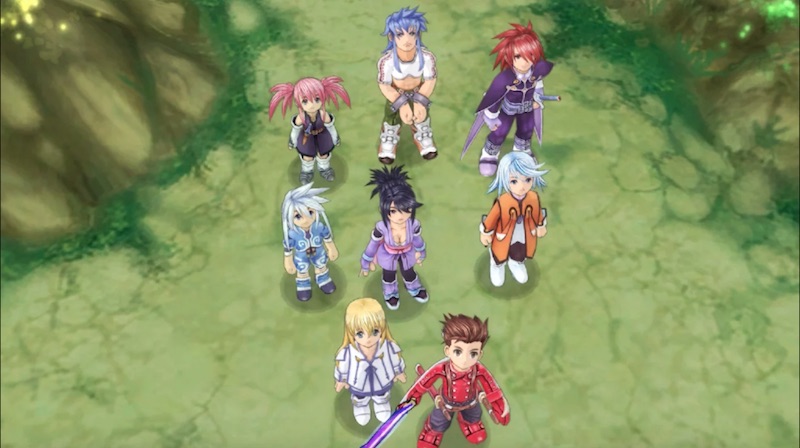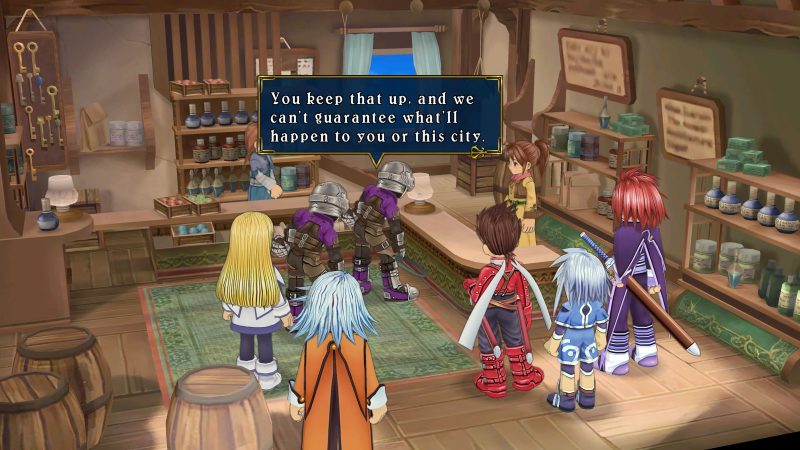Tales of Symphonia Remastered PS4 Review – My life has progressed literally two decades since the last time I played Tales of Symphonia. Going into this review, I thought I had formed some pretty clear memories of my time playing it on the Nintendo GameCube.
What I found instead is a game that creates cliches and some faux pas but still constructs a hearty narrative that keeps you moving forward. Unfortunately, a good deal of the game can easily get in the way of your overall enjoyment due to some noticeable flaws.
For transparency, this will act as a full game review that also reflects on Symphonia as a remastered product.
Tales of Symphonia Remastered PS4 Review – A Compelling But Cumbersome RPG Classic In A Lacklustre Remaster
Tales of Symphonia begins in the small village of Iselia, where young Colette begins her journey as the Chosen. Between global mana supplies dwindling and citizens landing in human ranches, a lot of pressure rests on Colette’s shoulders to successfully complete her journey. She must open the mana seals throughout Sylvarant and unlock her potential.
Several of her companions also come from the small village of Iselia: Lloyd, Genis, and Raine. While most of the game features the entire cast, Lloyd stands in as the main character. While a bit daft at times, he wants what’s best for everyone, sometimes to a fault. Above all, he wants to ensure Colette’s safety on her journey to save the world.
What has kept Symphonia at the top of the Tales series, and for some one of the best RPGs, is its story first and foremost. It touches on many heavy topics, like slavery, racism, social status, and biological versus inherited family. The game also lets every single character behave around these themes instead of making sweeping statements.
This allows the many different levels of moral dilemmas to present themselves. For instance, many citizens accept the times as long as they don’t draw any attention to themselves. Others clearly state their stance and even act to match their outlook. In all honesty, most of these themes pop up along the way, but the focus remains on the objectives the main characters pursue.
To boot, the game combines almost blatantly predictable beats with spontaneous twists. Combining all of this makes the narrative formula both easy to consume and compelling enough to draw interest.
Strength In Simplicity
Gameplay in general focuses on simplicity across the board. Leveling increases character stats in the background, and applying equipment to the characters is a simple affair. If you wish to enhance your stats more than what leveling gives you, the game lets you equip Ex Gems, which let you choose different stats to add to the equipped character.
Even better still, Tales of Symphonia allows you to see if a weapon is an upgrade when you shop. There’s an option to see the specifics if you wish, but the default is just arrows that indicate upgrade or downgrade.
Abilities unlock naturally as you play, either unlocking at certain levels or when you use other abilities enough times. You can either be rewarded with more options by digging into your abilities or simply keep to specific abilities and still succeed.
This is the formula for the game as a whole: simplicity with layers. The game wants you to enjoy the experience how you wish. The systems behind these simplicities don’t go too deeply, but the game offers enough options to keep things interesting for those who want it.
Combat itself is also simple, showcasing a rather basic action-based combat system. You juggle standard attacks and abilities. Abilities use Skill Points (SP), which regenerates naturally as you use standard attacks. For your party mates, you can also let the game make combat decisions for you, or you can dig into settings. You can even fully manually control your characters if you so choose, but the automatic combat options, and even the default settings, allow you to succeed.
Fundamental Faux Pas
Unfortunately, the pacing of this game relies on globetrotting to and from story beats and a camera that incessantly fights with you. At several points in the game, you need to run not just across a continent but across the map, even before you unlock any form of faster transportation. Combine this with a couple of scenarios where your objectives leave your next steps wide open, and Symphonia creates plenty of opportunities for roadblocks.
There’s also issues with the camera. Every time you enter the world map, the camera faces your character. You either use the Right Joystick or the R1 and L1 buttons to rotate the camera, but the camera rotates terribly slowly. Enemies don’t cake the map by any means, but you can easily run into enemies without meaning to.
The camera tries to adapt to the topography as you move, angling down when your character goes down an incline. This causes tons of issues just because this camera effect kicks in with every possible incline, no matter how shallow the incline.
So, half the time, the camera angles downward, leaving your character at the top of the screen and a bunch of the ground behind you. Thankfully, the map layout doesn’t demand much of you, since most locations stand in plain sight. The problem still pops up far too often and, when coupled with the other possible frustrating scenarios the game creates, add further layers of frustration.
Difficulty Spikes
Finally, the jumps in difficulty between boss fights ask a great deal of you, even if you spend time customizing your character’s gear and stats. Some major fights let you mindlessly beat on the boss, even when you’re outnumbered, and have no issues. Then, a handful of bosses ask you to strategize far more than the others do. The problem isn’t in the demand for strategy but rather in that the game never asks you to do so outside of these few points.
It wouldn’t even be so bad if you could easily level up and then come back. You can’t do that, though, not without a great deal of effort, because the enemies around you grant too little experience to make them worth the effort. You either run a great distance to level up or bash your head against the boss until you win.
Thankfully for the game and for those who dive in now, Symphonia has tons of guides on the internet to make the whole experience easier to manage. Still, relying on a guide to enjoy a game isn’t a universal positive.
“Remastered”
Calling this release a remaster feels more like a technicality than a showcase. The main character models have more defined details, and everything has an increased resolution. Nothing has extra details or enhancement. Even the audio remains the same. You can definitely hear it in the sound effects, like how a campfire sounds more like flipping through a deck of cards. Such were the times, but the lack of refinement shows.
One oddity I constantly came across is a visual discrepancy with the cel shading on secondary characters. To be clear, I’m referring to some bosses and enemies, not random no-name people along the way. Some looked like they were superimposed and almost going out of focus.
The most peculiar example comes with Kratos, a main character in the game. Many times, his mouth isn’t where it needs to be, often down at the base of his chin, even as he talks. This may be an effect of playing this PS4 game on PS5 like I did. Since it only happens with Kratos, I don’t think the PS5 emulation is the cause.
To top it off, optimization isn’t universal. Going in and out of battle loads in a second or two, but going in and out of the world map takes about six seconds. Considering all the other PS4 games with more demanding tech that loads faster, very few resources, if any, went into improving the game’s performance.
A Worthwhile Classic In Need of Refinement
Tales of Symphonia shows exactly why it has held its classic status all this time: a compelling story that does the right things well. Many of its inherent flaws can easily be overlooked because the game delivers such a simplistic and accessible game loop around an engaging and at times gripping narrative. Its problems stand out a great deal, however, and have undoubtedly held back many gamers from seeing it through to the end.
The effort to remaster Symphonia lacks the kind of care to make this release a must-buy. At the same time, the cost of convenience may bring some around to it in the end. Either way, its $40 price tag compares to its GameCube counterpart if you have the hardware available. This release is still a decent option, but it does very little to separate itself from its original version.
Review code kindly provided by publisher.
Tales of Symphonia Remastered is out now for PS4, PC, Nintendo Switch and Xbox One.








